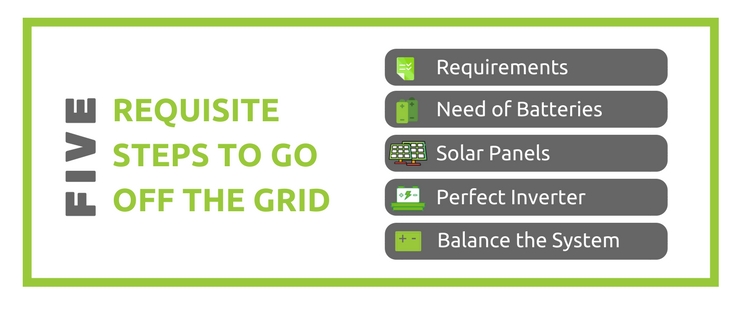5 Essential Steps for Procuring Off-Grid Solar Solutions
Going off the grid simply means independence from the utility grid. The scope of off-grid solar, however, is quite large and engulfs many considerations from different perspectives. It ensures several benefits for the asset owners, and at the same time, it also demands certain responsibilities. Going off the grid with off-grid solar solutions is becoming more and more reasonable. With many options to choose from while updating the solar and battery storage, the desire to disconnect oneself entirely from the utility grid is gaining support from the asset owners.
If you have been stirred up to procure an off-grid solar system, have a look at these 6 steps:
Step 1: Analyze your requirements
You must have the precise answer to what you will be powering with your solar power system. You must remember to take into consideration absolutely everything that will be powered by your system. Changes that often seem little can make a big difference.
Step 2: How many batteries would you need?
Once you know how much power you need, you must figure out how many batteries will be required to store that power. The question is whether you need only enough storage for 1 day or 2 or more, that is, to store 3 or 4 days, or even more, worth of power? If in case you have another source of power, like a generator or turbine, your power needs would be different.
Step 3: Number of solar panels
Once you have the idea about how much energy you need to make per day, you can easily calculate how many panels, and of what capacity would be required. This is determined using the concept of sun hours. The number of “sun hours” is the hours of availability of the shining sun on your panels at an angle throughout the day. The sun is not as bright in the morning as it is at noon, so an hour of morning sun may be counted as half an hour, where the hour from noon to 1PM would be a full hour. Also, you would not have the same number of hours of sunlight in the winter as you do in the summer, unless you live near the equator.
Step 4: Selecting the right Inverter
Once the batteries have been charged efficiently, we need to make the power usable. Always remember that an inverter is designed for a specific voltage battery bank, such as 12, 24 or 48 volts, so you must have the idea what voltage battery bank you are going to have before you procure the inverter. Be careful in case you are planning to grow your system in the future. If you plan to have a higher voltage battery bank later, the lower voltage inverter will not work in the new bigger system. So, either plan in advance and go with the higher voltage at the beginning or plan on changing your inverter in the future.
Step 5: Keeping the system in balance
To keep the system in balance, there are a lot of other little components needed, including the fuses and breakers for over current protection, breaker boxes, mounting structure for the solar panels, size of the wire needed.
With these 5 steps in place, going solar with off-grid solar solutions will be a smart move.



